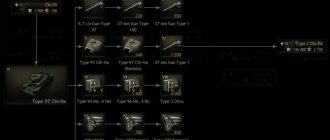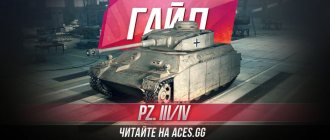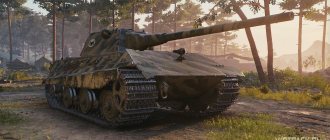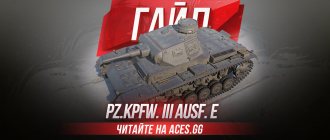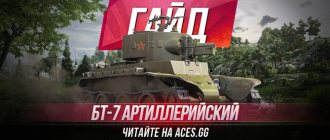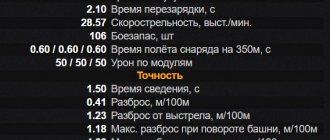The Type 97 Chi-Ha was a Japanese medium tank that saw heavy use during World War II alongside the more obsolete Ha-Go. In terms of mass, the Chi-Ha was rather light - it could only be classified as medium according to the Japanese classification.
The history of the creation of Chi-Ha
By the mid-30s of the 20th century, Japan's main medium tank, the Type 98, was completely obsolete. The Japanese command revised the requirements for medium tanks and ordered the development of more maneuverable vehicles. In 1936, the final technical specifications for the new medium tank were formulated - it was supposed to be faster, more secure, smaller, and at the same time retain the same weapons. Two prototypes were made - “Chi-ha” from and “Chi-ni” from the Osaka Arsenal.
In 1936-1937, prototypes were tested, and at first preference was given to the lighter and cheaper Chi-Ni. But after the first major military clashes with China, it became obvious that the maneuverable and armored Chi-Ha would perform better. As a result, it was accepted into service, designated as “Type 2597”. In 1937, the tank began to be mass-produced.
Links[edit]
- Drink, Christopher. (1996). 20th Century Armored Fighting Vehicles, Tiger Books International, London.
- Cooks, Alvin D. (1985). Nomonhan;
Japan vs. Russia, 1939 (two volumes) . Stanford, CA: Stanford University Press. ISBN 0-8047-1160-7. - Foss, Christopher (2003a). The Great Book of Tanks: The World's Most Important Tanks from World War I to the Present
. Zenit Press. ISBN 0-7603-1475-6. - Foss, Christopher (2003b). Tanks: 500. Crestline. ISBN 0-7603-1500-0.
- Gander, Terry J. (1995). Jane's tanks from World War II. Harper Collins. ISBN 0-00-470847-4
- Tomczyk, Andrzej (2007) [2002]. Japanese Armor Vol.
2 . AJ Press. ISBN 978-8372371119. - Tomczyk, Andrzej (2005). Japanese Armor Vol.
4 . AJ Press. ISBN 978-8372371676. - Zaloga, Stephen J. (2007). Japanese tanks 1939–45
. Osprey. ISBN 978-1-8460-3091-8.
Performance characteristics (TTX)
general information
- Classification: medium tank, although by world standards it was more of a light tank;
- Combat weight - 15.8 tons;
- Layout – transmission compartment in front, engine compartment in rear;
- Crew – 4 people;
- Years of production – 1938-1943;
- Years of operation – 1938-1945;
- Quantity produced: 2123 pieces.
Chi-Ha layout
Dimensions
- Case length – 5500 millimeters;
- Case width – 2330 millimeters;
- Height – 2380 millimeters;
- Ground clearance - 420 millimeters.
Booking
- Armor type – surface-hardened rolled steel;
- Body forehead (middle) - 10/82°-20/65° mm/degree;
- Hull side (top) - 20/25-40° mm/degree;
- Hull stern (top) - 20/67° mm/degree;
- Bottom – 8.5 mm;
- Housing roof – 10-12 mm;
- Tower forehead - 25/10° mm/degree;
- Tower side - 25 / 10...12° mm/degree;
- Feed cutting - 25/12° mm/degree;
- Tower roof – 10 mm.
Armament
- Make and caliber of gun – Type 97, 57 millimeters;
- Gun type - rifled;
- Barrel length - 18.4 calibers;
- Gun ammunition - 120;
- Angles VN: -9…+21;
- Sight – telescopic;
- Machine guns - 2 × 7.7 mm Type 97.
Mobility
- Engine type - Twelve-cylinder diesel V-shaped, liquid-cooled;
- Power – 170 horsepower;
- Highway speed – 38 km/h;
- Cross-country speed – 19 km/h;
- Cruising range on the highway – 210 km;
- Specific power – 10.8 hp/t;
- Suspension type – Khara;
- Climbability - 30-35 degrees;
- The wall to be overcome is 1 meter;
- The ditch to be overcome is 2.5 meters;
- The ford that can be overcome is 1 meter.
Design description[edit]
Hull and armoredit
“Shinhoto Chi-Ha” differed from standard “Chi-Ha” primarily in a new tower. In addition, the thickness of the armor was slightly increased and the gunner's hatch, which was covered by a new turret, was removed. The engine room ventilation system was improved and armored shutters were installed, and the commander received a new light and sound communication system with the driver, similar to a ship's telegraph. “Shinhoto Chi-Ha”, received by the troops by converting old vehicles, in addition to the new turret, received only a modified top hull plate without a gunner’s hatch. The armored hull of the tank had a complex shape, asymmetrical in the upper part, with fender niches.
The new tower consisted of two front and rear halves assembled by welding, connected by rivets. The extensive aft niche of the turret served for storing ammunition. The machine gun was still installed in the rear of the turret, despite the obvious failure of this decision.
| Armor type | rolled steel homogeneous |
| Body forehead (top) | 27 mm / 15° |
| Body forehead (middle) | 17 mm / 82° |
| Body forehead (bottom) | 20 mm / 65° |
| Hull side (top) | 20 mm / 25-40° |
| Hull side (bottom) | 20-25 mm / 0° |
| Hull stern | 20 mm / 30-67° |
| Bottom | 8.5 mm |
| Housing roof | 10-12 mm / 70-90° |
| Tower forehead | 25 mm / 10° |
| Tower side | 17 mm / 10° |
| Tower stern | 16 mm / 5° |
| Tower roof | 11 mm / 70-90° |
Armamentedit
The 47-mm Type 1 cannon with a 62-caliber barrel, mounted on most of the Shinhoto Chi-Ha, fired an armor-piercing projectile weighing 1.53 kg, containing 18 g of explosive, with a muzzle velocity of 830 m/s.
At a distance of 500 m, such a projectile penetrated 68 mm of armor at an impact angle of 90°. In addition, the ammunition included high-explosive fragmentation shells weighing 1.4 kg, containing 90 g of explosive. Armor penetration table for 47 mm tank gun Type 1
(armor-piercing tracer sharp-headed projectile)
| Range, m | At a meeting angle of 90°, mm | At a meeting angle of 60°, mm |
| 500 | 68 | 50 |
| 1000 | 45 | 34 |
Engine and transmissionedit
Shithoto Chi-Ha was equipped with a V-shaped 12-cylinder two-stroke air-cooled Mitsubishi diesel engine with a power of 240 hp. Mechanical transmission.
Chassisedit
The chassis of the Chi-ha tank was not particularly original. For one side, it consisted of the following elements: six double rubber-lined rollers; the four middle ones were blocked in pairs and equipped with a Hara-type suspension, and the outer rollers were equipped with an individual spring suspension; three support rollers; rear guide wheel; front drive wheel; small-link caterpillar: 96 tracks with one ridge, 330 mm wide and 120 mm pitch.
Chi-Ha modifications
So the Chi-Ha was very successful and popular, so several modifications were built on its basis, which were actively used along with the base tank.
Shinhoto Chi-Ha
When Japanese troops clashed with Soviet troops at the Khalkhin Gol River, it became clear that tank guns should primarily have anti-tank properties. So in 1939, the “ShinhoTo Chi-Ha” was developed - a modification with a new turret and a 47 mm cannon. It had a smaller caliber, but due to its length, the projectile was given a high initial velocity, so the new gun penetrated tank armor much better. Shinhoto were produced along with regular Chi-Ha until 1943.
Shinhoto Chi-Ha
Chi-Ha with a 120 mm cannon
On the basis of the Shinhoto, by order of the Marine Corps, they created a variation with a short-barreled naval gun with a caliber of 120 millimeters. This tank was produced after 1942 in small quantities.
Chi-Kee
It was a command tank - the turret was occupied by radio equipment and contained a 57-mm gun, and in place of one machine gun a 37-mm cannon was installed.
Historical background and general information
The Type 97 Chi-Ha was developed by the Japanese company Mitsubishi during 1935-1937. This model went into mass production in 1938 and was produced until 1942. It is worth noting that for two years, from 1941 to 1942, the Type 97 Chi-Ha was produced along with an improved version of the Shinhoto Chi-Ha. In total, about 2900 vehicles were produced. Both of the above samples were used by Japanese troops during the fighting in China. In 1946-1949, these tanks were also used in the Civil War by the Kuomintang army and the troops of the People's Liberation Army of China.
In order to gain access to the Type 97 Chi-Ha, you will only need to earn 1,460 experience on the previous tank. The cost of Type 97 Chi-Ha is also low and amounts to 45,000 silver. I offer you several options for boarding the crew on this tank:
Crew training for gold. I do not recommend this method, since the gold spent will be much more useful on high-level vehicles. Moreover, at this level, purchasing 100% of the crew is not critical and not mandatory. If you still decide to spend a few “rubles”, then I inform you that such training will cost you 4 * 200 = 800 gold.
Crew training for silver. Just what you need for a third level tank. Cheap and cheerful. As a result, you will see that for our purposes, a crew with 75% skill is quite enough. The cost of purchasing tankers for silver will be 4 * 20,000 = 80,000 silver.
It’s better to wear camouflage; after all, the Type 97 Chi-Ha has rather modest dimensions and a low profile. The cost of applying “camo” for 1 month for all types of cards will cost you 3 * 30,000 = 90,000 silver.
Vehicles based on Type 97 Chi-Ha
In addition to various modifications based on the Chi-Ha tank, other vehicles were also created.
Anti-tank:
- Ho-Ro is a self-propelled howitzer. Instead of a turret, a 150 mm howitzer was installed. Only about 12 were produced;
- Ho-Ni is a whole series of self-propelled guns. The design was similar to the Ho-Ro, but the Ho-Ni III had a closed conning tower. Mainly used for fire support. They were the only more or less mass-produced self-propelled guns in Japan during World War II (about 170 were produced).
Ho-Ni I is a self-propelled gun based on the Chi-Ha.
Special:
- Ka-Ha is a machine for destroying wired communication lines through the action of a dynamo with a direct current generator. The creators assumed that it would destroy communications via telegraph wire. A total of four such machines were built, but there is no data on their use;
- Ka-So is an armored vehicle for artillery observers. It had no weapons in the tower;
- Ho-K is a logging machine used in the jungles of New Guinea;
- Chi-Yu is an armored mine sweeper with a turret and weapons.
Repair and technical
- Se-Ri is a repair and recovery vehicle. A small conical turret with a machine gun was placed on it, and on the stern there was a crane with a lifting capacity of 5 tons. Only a couple of copies were produced;
- T-G is an armored bridge-laying vehicle that made it possible to assemble a bridge with the help of two missiles - the bridge literally flew out of the car in a few seconds. At the same time, the resulting bridge could hold Japanese tanks, but failed under American ones. However, the T-G was never mass-produced.
Design
The layout of the "Chi-ha" was similar to the "Ha-go", but had a two-man turret. The control compartment housed the driver (right) and gunner (left); in the turret to the right of the gun is the commander, to the left is the loader. The hull and turret were riveted. The hull had side niches and an inclined gable upper frontal plate. The tower was made with a slight taper and a rear niche. On the roof of the tower there was a commander's dome with a large double-leaf hatch, and to the left of it was a double-leaf loader's hatch. The driver had a hatch in the roof of the cabin, and the gunner had a hatch in the roof of the hull. Horizontal viewing slits were cut into the deckhouse window panel and its arched cheekbones.
The installation of the 57-mm “97” gun in the “Chi-ha” turret allowed it to swing in the horizontal plane within plus or minus 5°. The elevation angle of the gun was 21°, the descent angle was 9°. The weight of a 57-mm projectile is 2.7 kg, the initial speed is 420 m/s. One machine gun in a ball joint was mounted in the rear of the turret on the left, the second on the left in the front plate of the hull.
A two-stroke V-shaped diesel engine was installed longitudinally in the stern, access to it was provided by hatches in the sides and hatch-blinds in the hull roof. In combat conditions, the blinds on the sides were covered with armored covers. On the march, they rose and were fixed in a horizontal position. Fuel tanks of 120 and 115 liters were located along the sides. Exhaust pipes were led back from both sides. A four-speed gearbox with sliding gears and a reduction gear gave 8 forward and 2 reverse gears. The chassis according to T. Hara's scheme was supplemented with front and rear rollers with independent suspension: the outer rollers were connected through crank arms to inclined spiral springs, openly mounted on board. The track rollers and outer support rollers were double. There were no shock absorbers in the suspension. Unlike the experienced “Chi-nu,” “Chi-ha” did not have a “tail.”
A periscope observation device was mounted in the commander's hatch cover and there was a hole for signaling with flags. Headlights and sometimes a sound signal were attached to the front plate of the hull or to the fenders.
Clashes with Soviet troops at Khalkhin Gol convinced the Japanese of the priority of the anti-tank properties of the tank gun. And already in 1939, an experimental tank “98” (“Chi-ho” - “middle fifth”) was built with an enlarged turret similar to the Soviet BT-5 and a slightly modified chassis. And in 1940, a modification of the serial “97” appeared - “Shinhoto Chi-ha” (“Chi-ha” with a “new artillery turret”) with a 47-mm cannon: with a barrel length of 48 calibers, its 1.4-kg projectile had an initial speed 825 m/s and penetrated 75 mm armor at a distance of 500 m. The ammunition included armor-piercing and armor-piercing fragmentation shells. The machine guns were placed similarly to the Chi-ha. The turret had a dome with viewing slots; a rack for an anti-aircraft machine gun was mounted on its roof in front of the loader's hatch. There were hatches for firing personal weapons. There was a small hatch on the right side of the turret, and a wide hatch in the rear wall to the right of the machine gun for evacuation, loading ammunition and dismantling the gun. Most of the Shinhoto Chi-has were simply remakes of already released Chi-has. The newly produced tanks had a slightly modified engine compartment ventilation system. The commander had light and sound communication with the driver: 12 buttons on the commander’s remote control corresponded to 12 illuminated banners and a buzzer on the driver’s panel.
Combat use
Chi-Ha tanks had not yet been used in the battles at Khalkhin Gol, but were only tested at the front. After the defeat, it was decided to replace many of the Ha-Go with the Type 97 Chi-Ha, so they began to be produced more actively.
In 1941, the Japanese invaded Malaya and the Philippines. In battles with American tanks, the “Ha-Go” mainly took part, but the medium “Chi-Ha” were also used by Japanese troops to accompany the infantry and finally break the enemy.
In the battles on Bataan, the Chi-Has were used much more actively, but in the end it turned out that their 57-mm weapons were ineffective against the American Stuarts. Therefore, two Shinhoto Chi-Has were transferred to the islands. This modification was first used in the landing on Corregidor, May 5, 1942.
In Malaya, the Chi-Ha was also used actively and very successfully, mainly due to the fact that the enemy did not have anti-tank weapons. Tanks played a special role in the capture of Singapore on February 15.
In 1943, Japan in the Pacific and Asia was forced to move from offensive to defensive. To achieve this, all units were actively equipped with tanks, both “Chi-Ha” and “Ha-Go”, as well as amphibious and other modifications.
In the battles on the island of Saipan in July 1944, Japanese tank forces clashed with American tanks. As a result, many Japanese vehicles were lost under fire from M4s and M3 anti-tank guns. Much the same thing happened on the island of Guam.
In the Pacific theater of operations, these two islands became the sites of the most active use of Japanese tanks. It was here that it became clear that the Chi-Has were already outdated - they were too easily penetrated by American cannons and even heavy machine guns.
Type 97 Chi-Ha with tank driver
Philippines and Japanese islands
In the Philippines, Japanese tanks also did not perform very well - in battles with American tanks, especially Shermans and self-propelled guns, many Chi-Ha and Shinhoto Chi-Ha were lost. Japanese tanks also failed in the defense of Iwo Jima, Okinawa and Formosa. True, one stronghold with three Shinhoto Chi-Has managed to put up stubborn resistance - the fighting on the island of Iwo Jima lasted from February to March 26. But in the end, the resistance was still crushed. Tanks hardly took part in the fierce battles on Okinawa. Moreover, because of the defeat in the Philippines, the Japanese did not risk transferring tanks to Okinawa.
Chi-Ha, shot down in the Philippines
Continental battles
On the continent, the Chi-Ha fought in Burma and China. In Burma, the last Japanese tanks were killed in a clash with Shermans in March 1945. In China, tanks acted more successfully, mainly due to the enemy’s weak anti-tank defense. By the way, when Japan surrendered, the third tank division operating in China was not completely disarmed - it was used to defend Peiping from the National Liberation Army.
When the Manchurian Offensive of the Soviet troops began, the Kwantung Army had several tank brigades and regiments armed mainly with the Chi-Ha and Shinhoto Chi-Ha. In total there were 1215 tanks in the group. In general, their use was unsuccessful, and they were defeated. The same thing awaited Japanese tanks on the Kuril Islands - the remains of the Shinhoto Chi-Ha can still be seen on Paramushir Island.
After Japan surrendered, the Chi-Ha was used in the Third Chinese Civil War by both sides. They were mainly used to support infantry. In Japan itself, the Chi-Has were in service until the 60s, but were used more as training vehicles.
Notes[edit]
- ^ a b Zaloga 2007, p. 17.
- ^ abcde Pledge 2012, p. 23.
- ↑ ab Zaloga 2007, p. 13, 14.
- Tomczyk 2007, pp. 19, 21.
- Zaloga 2007, p. 14.
- Zaloga 2007, p. 16.
- Zaloga 2012, pp. 12, 13.
- Zaloga 2007, p. 35.
- Zaloga 2007, pp. 34-40.
- Zaloga 2007, pp. 11, 41.
- Tomczyk 2005, p. 61.
- Tomczyk 2005, pp. 61, 62, 71, 76, 82.
- Tomczyk 2007, p. 19.
- Zaloga 2012, p. 15.
- ^ a b Pledge 2007, p. 42.
- Tomczyk 2007, pp. 19, 22.
- ^ a b Zaloga 2007, p. 21.
- Tomczyk 2005, pp. 36, 37.
- ^ ab Imperial Japanese Army Taki: 12 cm self-propelled gun with long barrel
Memory of a tank
Museums today house three Chi-Ha tanks, and there are also 11 vehicles that were heavily damaged in battle:
- Indonesia, Malanga, National Museum;
- PRC, Beijing - People's Revolutionary Museum;
- Japan, Yasukuni Shrine;
- Japan, Tank School of the Imperial Japanese Army;
- Russia, Ivanovskoye village in the Moscow region, Military Technical Museum. The tank is on the move;
- Russia, Kuril Islands, Shumshu Island. Several damaged tanks;
- On the islands of Guadalcanal, Saipan and Duke of York Island there are 9 Chi-Ha tanks abandoned by crews or damaged in battle.
Remains of Shinhoto Chi-Ha on the Kuril Islands
Content
- 1 History and development
- 2 designations of Japanese tanks
- 3 Design 3.1 Development of the improved Shinhoto Chi-Ha
- 6.1 World War II
- 10.1 Tanks of comparable role, performance and era
Tank photos
Shot down Chi-Ha
Type 97 Chi-Ha at the US Army Museum in Aberdeen
Shinhoto Chi-Ha with crew
Optional equipment
The Type 97 Chi-Ha is no different from its younger brother, having completely inherited its equipment package. Of the entire list of available devices, the most useful were “drives” and “ventilation”. As for the third slot, I leave “optics” and “stereo tube” to your choice. What exactly to buy is up to you. But, since playing on the Type 97 Chi-Ha involves more close-quarters combat, I think that “optics” would be a more optimal option. Prices are listed below:
- “Reinforced aiming drives” – 500,000 silver
- “Improved ventilation Class 1” – 50,000 silver
- “Stereotube” – 500,000 silver
- “Coated optics” – 500,000 silver

